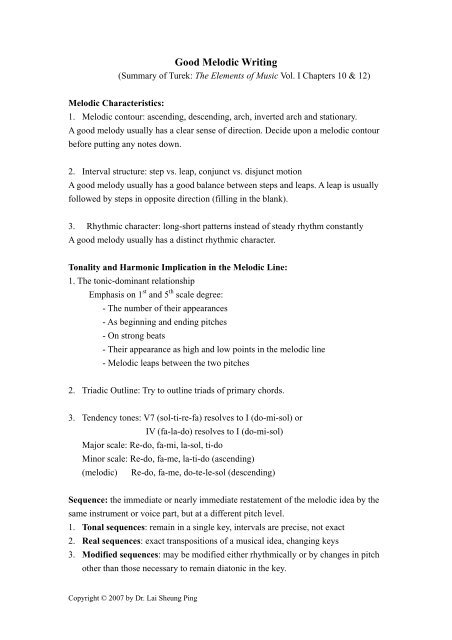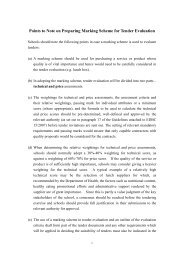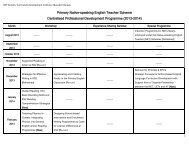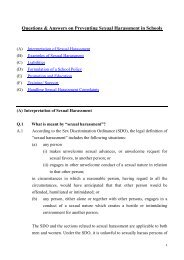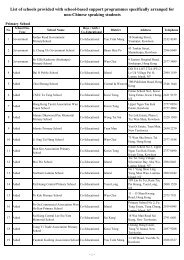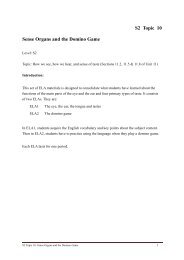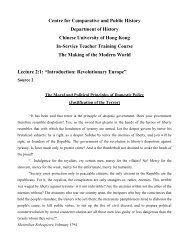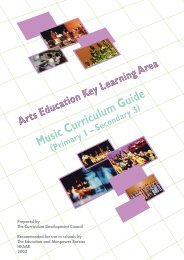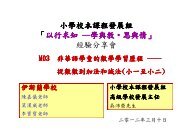Create successful ePaper yourself
Turn your PDF publications into a flip-book with our unique Google optimized e-Paper software.
Good Melodic Writing<br />
(Summary of Turek: The Elements of Music Vol. I Chapters 10 & 12)<br />
Melodic Characteristics:<br />
1. Melodic contour: ascending, descending, arch, inverted arch and stationary.<br />
A good melody usually has a clear sense of direction. Decide upon a melodic contour<br />
before putting any notes down.<br />
2. Interval structure: step vs. leap, conjunct vs. disjunct motion<br />
A good melody usually has a good balance between steps and leaps. A leap is usually<br />
followed by steps in opposite direction (filling in the blank).<br />
3. Rhythmic character: long-short patterns instead of steady rhythm constantly<br />
A good melody usually has a distinct rhythmic character.<br />
Tonality and Harmonic Implication in the Melodic Line:<br />
1. The tonic-dominant relationship<br />
Emphasis on 1 st and 5 th scale degree:<br />
- The number of their appearances<br />
- As beginning and ending pitches<br />
- On strong beats<br />
- Their appearance as high and low points in the melodic line<br />
- Melodic leaps between the two pitches<br />
2. Triadic Outline: Try to outline triads of primary chords.<br />
3. Tendency tones: V7 (sol-ti-re-fa) resolves to I (do-mi-sol) or<br />
IV (fa-la-do) resolves to I (do-mi-sol)<br />
Major scale: Re-do, fa-mi, la-sol, ti-do<br />
Minor scale: Re-do, fa-me, la-ti-do (ascending)<br />
(melodic) Re-do, fa-me, do-te-le-sol (descending)<br />
Sequence: the immediate or nearly immediate restatement of the melodic idea by the<br />
same instrument or voice part, but at a different pitch level.<br />
1. Tonal sequences: remain in a single key, intervals are precise, not exact<br />
2. Real sequences: exact transpositions of a musical idea, changing keys<br />
3. Modified sequences: may be modified either rhythmically or by changes in pitch<br />
other than those necessary to remain diatonic in the key.<br />
Copyright © 2007 by Dr. Lai Sheung Ping
Melodic Form<br />
I. Melodic Units: motive, phrase, phrase members, melodic cadences<br />
Phrase Relationship: repetition (exact or varied), (a or a’)<br />
similarity, contrast (b)<br />
II. Phrases in Combinations:<br />
Period: 2-phrase unit where the 2nd one ends more conclusively than the 1st one.<br />
(Phrase 1 ends on V; phrase 2 end on I.)<br />
Parallel period (a a’), Contrasting period (a b)<br />
Symmetrical (e. g. 4 + 4) and asymmetrical (e. g. 3 + 5) periods<br />
Three-phrase period (a b c)<br />
Double period: 4-phrase unit where the last phrase ends more conclusively than the<br />
previous ones.<br />
Phrase extension: internal extension, cadential extension (more common)<br />
* Refer to the book for musical examples.<br />
Copyright © 2007 by Dr. Lai Sheung Ping
Principles of Harmonization in Tonal Music<br />
Dr. Lai Sheung Ping<br />
1. Understand the harmonic implication of a melody. Differentiate between<br />
chord tones and non-chord tones.<br />
2. Harmonize the chord tones with appropriate diatonic harmony: e.g. In the key<br />
of C-Major, C can be harmonized by C-Major, A-minor and F-Major triads.<br />
3. Explore the possibilities of chromatic harmony: Make a list of different chords<br />
which share the same chord tone, e.g. C could also be harmonized by<br />
Ab-Major triad (bVI), D7 (V7/V), F# dim.7 (viio7/V) etc.<br />
4. Choose one/a few chords that belong to the same harmonic function in tonal<br />
context: e.g. In the key of C, C and Cm triads belong to tonic function; F, Fm,<br />
D7, Dm7, Do7, and Fr+6 belong to pre-dominant function; Ao7, F#o7 and<br />
D#o7 belong to secondary leading-tone function etc.<br />
5. Select the ones most suitable to the musical context: Underneath a melodic<br />
line, choose a series of chords which form a logical harmonic progression:<br />
Cycle of 5ths progression.<br />
Basic: iii vi ii or IV V7 or viio7 I<br />
Secondary: V7/vi V7/ii or V7/IV V7/V V7 or viio7 I<br />
Function viio7/vi viio7/ii or viio7/IV viio7/V V7 or viio7 I<br />
Borrowed: III VI iio7 or iv v (rare) or VII i<br />
Others: N6, It+6, Ger+6, Fr+6<br />
6. Observe voice-leading. Create a smooth bass line. Use appropriate inversions<br />
and NCTs.<br />
7. Apply chord extension and chord substitution to enhance harmonic color.<br />
8. Linear harmony is the result of smooth chromatic voice-leading in different<br />
parts. It does not have to be functional.<br />
9. Functional harmony is based on the concept of tension and release.<br />
Non-functional harmony does not need to follow traditional chord progression.<br />
For example, a series of unresolved dominant sevenths is simply for coloring.<br />
Copyright © 2007 by Dr. Lai Sheung Ping
20th Century Music Vocabulary<br />
Scales:<br />
Modes: Dorain, Phrygian, Lydian, Mixolydian, Aeolian, Locrian<br />
Pentatonic scale<br />
Whole-tone scale<br />
Octatonic scale<br />
Synthetic scales<br />
Twelve-tone series<br />
Harmony:<br />
Chords by Thirds with extension: 7 th , 9 th , 11 th , 13 th (Jazz harmony)<br />
Chords by Fourths: closely related to pentatonic scale<br />
Chords by Seconds: “tone cluster” if used in close position<br />
Added-note chords<br />
Polychords<br />
Mixed-interval chords<br />
Compound and Mirror Harmony<br />
Harmonic progression outside cycle of 5ths<br />
Key Centers:<br />
Modality<br />
Tonality<br />
Bitonality, Polytonality<br />
Atonality<br />
Rhythm:<br />
Complex subdivision of rhythm<br />
Irregular rhythmic grouping,<br />
Rapid change of meter<br />
Polyrhythm, Polymeter<br />
Sense of no pulse: static sound world<br />
Isorhythm: Medieval device, used in Messiaen’s music<br />
Metric modulation (tempo modulation): used by Carter<br />
Copyright © 2007 by Dr. Lai Sheung Ping
Texture:<br />
Pointillism: features rests and wide leaps, isolates the sounds into “points”<br />
Stratification: juxtaposition of contrasting musical textures/ sounds<br />
Sound mass (large clusters) as main focus of composition: e.g. Ligeti, Penderecki<br />
Timbre:<br />
Extended techniques of acoustical instruments<br />
Unconventional combinations of acoustical instruments<br />
Concrete music<br />
Electronically synthesized music<br />
Computer music<br />
Interaction between live music and electronics<br />
Fused-ensemble timbre (Spectral music)<br />
Form:<br />
Traditional forms continue. Formal proportion less balanced than before.<br />
Golden Mean/Golden Section (0.618): used extensively by Bartok<br />
Moment Form: anti-traditional organic approach of formal structure, used by Stockhausen<br />
Styles:<br />
Impressionist<br />
Expressionist: associated to Twelve-tone serial music<br />
Primitivist<br />
Neo-classical<br />
Neo-romantic<br />
Avant garde:<br />
Total (integral) serial<br />
Chance music<br />
Textural music<br />
Collage and Quotation<br />
Minimalist<br />
Electronic music<br />
Computer music<br />
Multimedia<br />
Spectral music<br />
Copyright © 2007 by Dr. Lai Sheung Ping
Pentatonic Scale 五 聲 音 階<br />
Whole-tone Scale 全 音 音 階<br />
Copyright © 2007 by Dr. Lai Sheung Ping<br />
Harmony (augmented triad only)
Modal interchange of Pentatonic Scale 五 聲 音 階 和 諧 轉 調 法<br />
Copyright © 2007 by Dr. Lai Sheung Ping<br />
Harmonization by fourths
Copyright © 2007 by Dr. Lai Sheung Ping
Comparison between modes and major / minor scale<br />
調 式 與 大 小 調 之 比 較<br />
Copyright © 2007 by Dr. Lai Sheung Ping
Melodies in Dorian mode<br />
Copyright © 2007 by Dr. Lai Sheung Ping<br />
Faure - Sicilienne<br />
English folk song - Greensleeves<br />
Simon & Garfunkel - Scarborough Fair<br />
李泰祥 - 橄欖樹
Phrygian Mode:<br />
Lili Boulanger: D’un malin de printemps<br />
Rodrigo: Guitar Concerto I<br />
Spanish guitar pattern<br />
Rodrigo: Guitar Concerto II<br />
Mixolydian Mode:<br />
Vaughan-Williams: The wasps Overture<br />
Gershwin: Borgy and Bess<br />
Lydian Mode:<br />
Bartok: Violin Concerto No.2<br />
Copyright © 2007 by Dr. Lai Sheung Ping
Bernstein: “Maria” from West Side Story<br />
Theme from The Simpsons (cartoon)<br />
Aeolian Mode:<br />
侯德健:龍的傳人<br />
Copyright © 2007 by Dr. Lai Sheung Ping
Scale 1<br />
Copyright © 2007 by Dr. Lai Sheung Ping<br />
Octatonic Scales<br />
Harmonic Implications<br />
Triads
Scale 2<br />
Scale 3<br />
Copyright © 2007 by Dr. Lai Sheung Ping
Scale 1<br />
Scale 2<br />
Copyright © 2007 by Dr. Lai Sheung Ping<br />
Sevenths
Scale 3<br />
Copyright © 2007 by Dr. Lai Sheung Ping<br />
Sets (non-tertian)
Copyright © 2007 by Dr. Lai Sheung Ping<br />
Modal Harmony
Copyright © 2007 by Dr. Lai Sheung Ping<br />
Chord Extension
Chords by fourths (Quartal harmony)<br />
Chords by seconds (Secundal harmony)<br />
Copyright © 2007 by Dr. Lai Sheung Ping
What are the problems with the following melodies?<br />
How can they be fixed?<br />
Rewrite each melody at the staff provided below.<br />
1.<br />
2.<br />
3.<br />
Copyright © 2007 by Dr. Lai Sheung Ping


